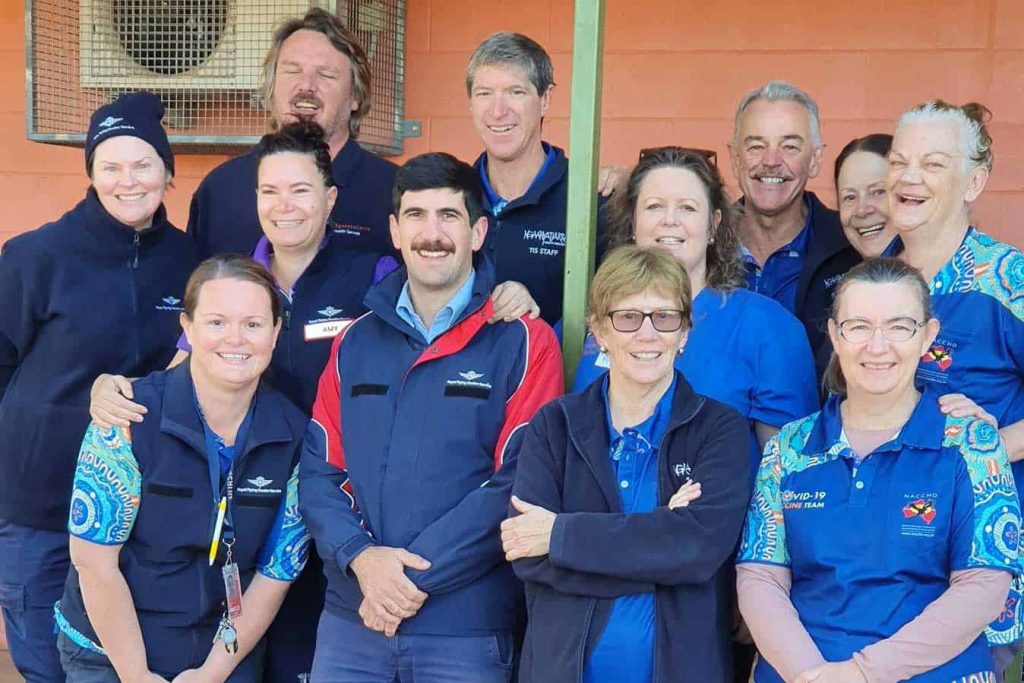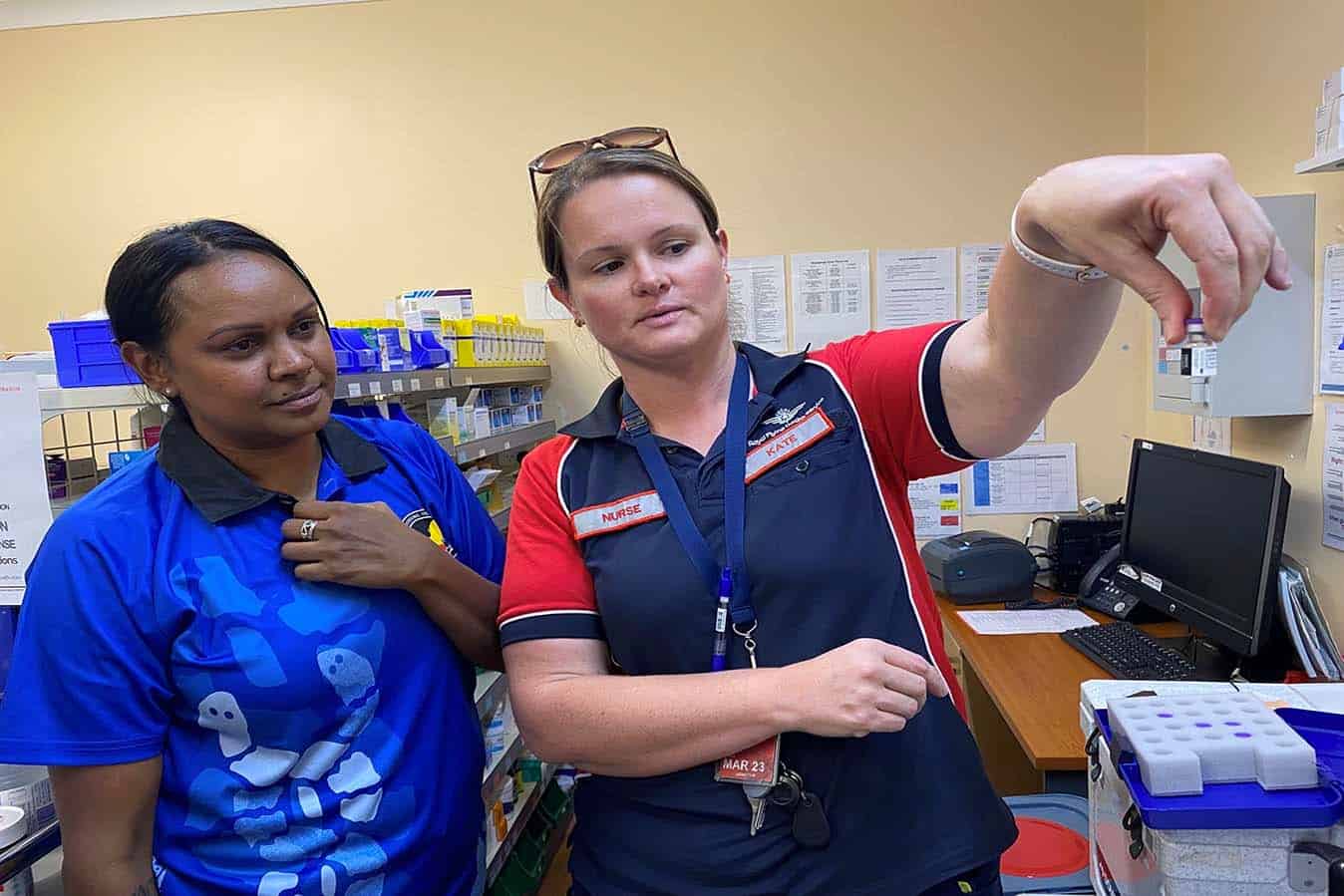As Australia’s COVID-19 vaccination campaign gathers pace, Kate Jones, one of the senior primary healthcare nurses of the Royal Flying Doctor Service, Western Operations, says it feels like her team is “contributing towards making history” helping vaccinate rural and remote communities in WA.
“Being able to protect some of our most remote and vulnerable people in the country from COVID-19, in the Kimberley region and throughout WA, is such an exciting opportunity,” says Kate, from the RFDS Broome base.
“It’s a really amazing program to be a part of and it’s very exciting to be able to directly contribute and rise to the challenges of our times with an incredible team and an incredible workforce.”
Nurses, particularly consultants and immunisers, are crucial to the RFDS’ national COVID-19 vaccination campaign, helping the organisation respond to the specific needs of rural and remote communities across the country, including Aboriginal and Torres Strait Islander peoples.
The RFDS continues to play a key role throughout the national response to the COVID-19 pandemic, organising around 3000 transfers of suspected COVID-positive patients by air and road, and providing key on-the-ground support during the crisis in aged care at the height of the Victorian second wave last year (2020).

Since the vaccination roll-out has gathered pace, the organisation has shifted its operations, administering more than 40,000 doses of the Pfizer-produced Comirnaty vaccine at the time of publication, with a large number of those doses received by clients in the last six weeks.
According to Dr Fergus Gardiner, the Director of the RFDS’ National COVID-19 Response, nursing-trained staff have formed a crucial part of the “locally-informed” RFDS deployment, which has also relied on close consultation with community, state and federal health departments.
“At any one time, we’ve got 14 teams on the ground, and the vast majority of those are nurses, and nurse-led,” Dr Gardiner says, adding that many of his state-based COVID leaders are nurse trained.
“We’ve been working tremendously hard, but I think it comes back to our dedication to our population in rural and remote Australia, and wanting to assist as much as possible”.
Kate performs a clinical coordination role as part of the Broome team for the vaccine roll-out. She says her team often work in groups of three to manage the logistics of transporting the vaccine to anywhere from one to up to three locations per day, carrying out a multitude of roles depending on what is required.

On any given day the RFDS could be transporting vaccines, administering vaccines, educating health care workers, and/or providing community health and vaccine promotion for communities they provide care to on a regular basis.
Additionally, Kate says the RFDS also provides some of the aforementioned vaccine support for the Kimberley Aboriginal Medical Service and the West Australian Country Health Service’s Kimberley team, depending on what their health care teams require.
“They are obviously the experts of their own communities, so we are guided by them as to what we need to do when we’re there,” Kate notes.
While WA’s success in containing the virus means that complacency and vaccine hesitancy can be an issue, Kate says the level of such scenarios varies from place to place, and person to person, with many people responding positively to the health promotion and education that the RFDS has provided.
“We have noticed that since the East Coast [situation], the vaccinations number have increased quite dramatically compared to when we first started,” she says, observing that some RFDS nurses need to spend up to an hour with patients answering questions before they decide to get vaccinated.
“We just keep pushing the health promotion and keep pushing the message that it will affect us one day, and we just have to prepare and plan ahead so we can be the strongest possible position before it gets here.
“It goes back to the basics of primary health care: Developing relationships, developing trust, and being able to sit down and give people the time that they need.”

Nevertheless, with high vaccination rates key to the nation re-opening, Kate says all relevant stakeholders, community organisations, government and healthcare workers, will continue working tirelessly with the remaining hesitant individuals and communities over the coming months, as WA’s vaccination roll-out accelerates.
In particular, she notes that building trust through health promotion with some remote Aboriginal communities remains ongoing, and the faster transmission rate that the current Delta variant brings will need to be recognised by people living in rural and remote settings, as part of the campaign to vaccinate children aged older than 12.
“The Delta strain has certainly brought on new challenges, and we can see that around the country it’s not doing what the other strains have done,” Kate says.
“It’s quite important to obviously not use too many scare tactics, but to make sure that people understand the importance of getting vaccinated if you’re eligible.”
Kate also urges anyone, regardless of where they are in Australia, to get vaccinated as soon as possible if they are able to do so.
“Please, please, go and get vaccinated,” Kate says.
“The only way we’re going to be able to stop this pandemic in its tracks and be able to see our friends and family, and to travel again, is to get vaccinated and I implore you to please do that.”








